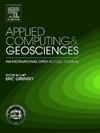Classification of geological borehole descriptions using a domain adapted large language model
IF 3.2
Q2 COMPUTER SCIENCE, INTERDISCIPLINARY APPLICATIONS
引用次数: 0
Abstract
Geological borehole descriptions contain detailed textual information about the composition of the subsurface. However, their unstructured format presents significant challenges for extracting relevant features into a structured format. This paper introduces GEOBERTje: a domain adapted large language model trained on geological borehole descriptions from Flanders (Belgium) in the Dutch language. This model effectively extracts relevant information from the borehole descriptions and represents it into a numeric vector space. Showcasing just one potential application of GEOBERTje, we finetune a classifier model on a limited number of manually labeled observations. This classifier categorizes borehole descriptions into a main, second and third lithology class. We show that our classifier outperforms a rule-based approach (by 30% on average), non-contextual Word2Vec embeddings combined with a random forest classifier (by 38% on average), and a prompt engineering method with large language models (i.e., GPT-4 (by 11% on average) and Gemma 2 (by 28% on average)). This study exemplifies how domain adapted large language models enhance the efficiency and accuracy of extracting information from complex, unstructured geological descriptions. This offers new opportunities for geological analysis and modeling using vast amounts of data.
基于域适应大语言模型的地质钻孔描述分类
地质钻孔描述包含有关地下成分的详细文本信息。然而,它们的非结构化格式对将相关特征提取为结构化格式提出了重大挑战。本文介绍了GEOBERTje:一种基于荷兰语法兰德斯(比利时)地质钻孔描述训练的领域适应大语言模型。该模型有效地从井眼描述中提取相关信息,并将其表示为数值向量空间。仅展示GEOBERTje的一个潜在应用,我们在有限数量的手动标记观测值上微调分类器模型。该分类器将井眼描述分为主要、第二和第三岩性类。我们表明,我们的分类器优于基于规则的方法(平均30%),非上下文Word2Vec嵌入结合随机森林分类器(平均38%),以及具有大型语言模型的提示工程方法(即GPT-4(平均11%)和Gemma 2(平均28%))。本研究举例说明了领域适应大语言模型如何提高从复杂、非结构化的地质描述中提取信息的效率和准确性。这为使用大量数据进行地质分析和建模提供了新的机会。
本文章由计算机程序翻译,如有差异,请以英文原文为准。
求助全文
约1分钟内获得全文
求助全文
来源期刊

Applied Computing and Geosciences
Computer Science-General Computer Science
CiteScore
5.50
自引率
0.00%
发文量
23
审稿时长
5 weeks
 求助内容:
求助内容: 应助结果提醒方式:
应助结果提醒方式:


